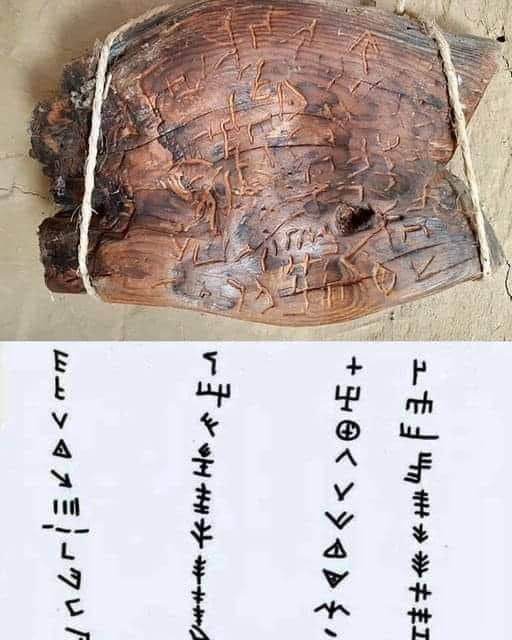The Dispilio Tablet, an extraordinary archaeological artifact discovered in Greece, has significantly altered our understanding of the origins of writing. Traditionally, historians have traced the emergence of written communication to the Sumerians around 3,000 to 4,000 BC. However, this 7,000-year-old tablet, unearthed in a Neolithic settlement near modern Dispilio on the shores of Lake Kastoria, provides compelling evidence that the development of writing may have begun much earlier than previously believed.
Unearthed in 1993 by Professor George Hourmouziadis from the Aristotle University of Thessaloniki, the Dispilio Tablet features enigmatic inscriptions that date back to before 5,000 BC. Radiocarbon dating has confirmed its age at approximately 5,260 BC, making it not only older than the earliest known Sumerian writing systems but also a possible precursor to the Linear B script of the Mycenaean Greeks. This discovery has profound implications, challenging long-standing theories about the timeline and evolution of writing as well as the cultural exchanges between ancient civilizations.

The markings on the Dispilio Tablet have yet to be deciphered, but they are believed to represent an early form of communication. Some researchers hypothesize that these inscriptions could have been used for practical purposes, such as recording possessions or managing rudimentary accounting systems. The existence of such a sophisticated artifact calls into question the widely accepted narrative that the ancient Greeks borrowed their writing systems entirely from earlier Middle Eastern civilizations. Instead, it suggests that early Greek societies may have independently developed their own form of written communication. Professor Hourmouziadis himself has championed this theory, emphasizing that the advanced nature of the tablet’s markings underscores the innovative capabilities of these ancient communities.
The implications of the Dispilio Tablet extend far beyond its age and origins. If this artifact indeed represents an early form of writing, it necessitates a reevaluation of the entire timeline of human communication. Scholars have long attributed the development of writing to the cultural and technological advancements of Mesopotamian civilizations. However, the Dispilio Tablet challenges this assumption, proposing that written communication could have arisen in multiple regions independently. This idea opens the door to a broader understanding of human ingenuity and the diverse ways ancient societies addressed the need for recording information and transmitting knowledge.
The tablet’s significance lies not only in its age but also in its broader cultural and historical implications. The discovery highlights the complexity of early human communication systems and the potential for independent innovation across different regions. While much of the academic focus has traditionally centered on Mesopotamian and Egyptian contributions to the evolution of writing, the Dispilio Tablet serves as a reminder that other cultures played a significant role in shaping the early history of written communication. This artifact underscores the idea that humanity’s intellectual achievements were not confined to one geographic area but were instead the result of widespread and varied innovation.
As researchers continue to study the Dispilio Tablet, the undeciphered markings remain a source of fascination and debate. Efforts to decode the inscriptions could provide critical insights into the early stages of human communication, revealing not only the practical applications of such systems but also the cultural and symbolic meanings embedded within them. These investigations have the potential to transform our understanding of the ways in which early societies organized themselves, recorded information, and interacted with their environments.

The discovery of the Dispilio Tablet also has broader implications for the study of ancient cultures. By challenging the conventional narrative that writing originated solely in Mesopotamia, this artifact compels historians and archaeologists to reconsider the interconnectedness of early civilizations. It suggests that the exchange of ideas, technologies, and cultural practices may have been more dynamic and widespread than previously assumed. This perspective aligns with a growing body of evidence pointing to the complexity and sophistication of Neolithic societies, which were capable of remarkable technological and artistic achievements long before the rise of well-documented ancient empires.
Furthermore, the Dispilio Tablet serves as a poignant reminder of the resourcefulness and creativity of our ancestors. Its very existence highlights the importance of questioning established historical narratives and remaining open to new interpretations of the past. Each discovery, such as this one, enriches our understanding of human history and sheds light on the diverse ways in which early societies responded to universal challenges, such as the need to communicate, document, and share knowledge.
In the broader context of archaeological discoveries, the Dispilio Tablet stands out as a testament to the ingenuity of ancient peoples. It invites modern audiences to appreciate the rich tapestry of human history and the myriad contributions of different cultures to the development of civilization. As researchers strive to unlock the secrets of its markings, the tablet continues to inspire both scholars and the public alike, serving as a bridge between the distant past and our understanding of the present.
Ultimately, the significance of the Dispilio Tablet lies not only in its challenge to conventional timelines but also in its affirmation of the shared human drive for innovation and expression. By reevaluating the origins and evolution of writing, this artifact deepens our appreciation for the complexities of ancient cultures and their lasting impact on the world. It is a powerful reminder that history is not a static record but a constantly evolving narrative shaped by new discoveries and insights. The Dispilio Tablet, with its ancient inscriptions and profound implications, will undoubtedly continue to shape our understanding of humanity’s story for generations to come.





